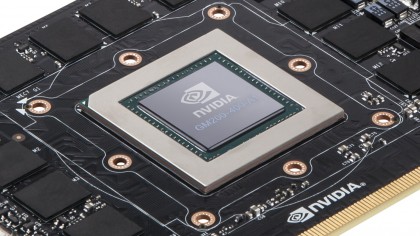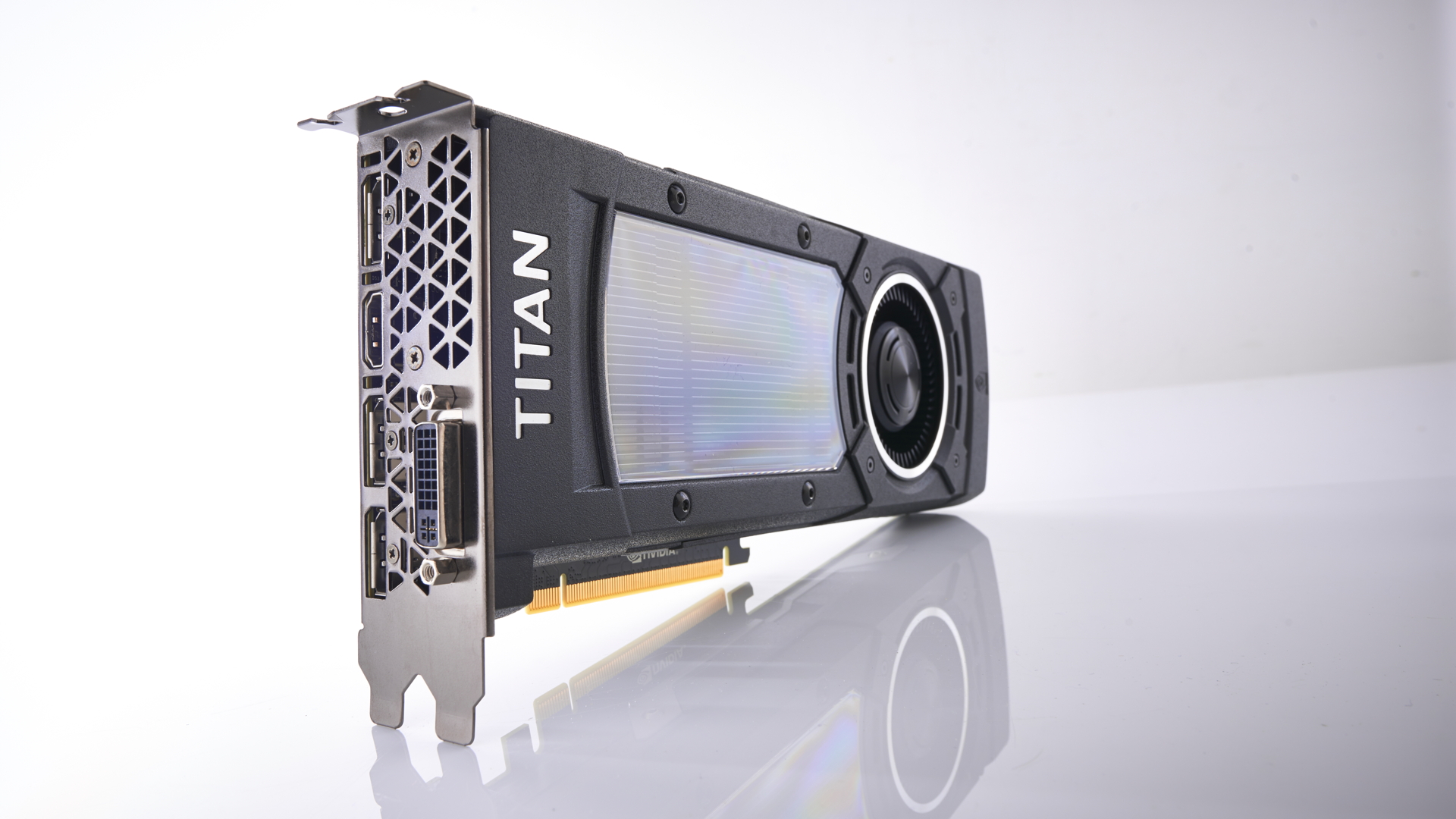Why you can trust TechRadar
The beating heart of the Nvidia GeForce GTX Titan X is the brand new GM 200 GPU at its core. This is what I mean by the full power of the Maxwell architecture – it's the biggest GPU core around, packing in 50% more processing tech than the GM 204 silicon in the GTX 980.
And the Titan X is housing the full GM 200 core too.
With the first Titan card Nvidia left some of the top Kepler core on the test bench, chopping out a few SMX units here and there, and other chunks of its full core configuration, to ensure it could hit the yields necessary on its big chip. It took another year for Nvidia to release the GTX Titan Black, rocking the full implementation of the GK 110 GPU.
This time around though both Nvidia's 28nm production process and its Maxwell architecture are mature enough for it to be able to confidently produce such complex 601mm2 slices of super-powered silicon with good yields.
And boy, is it complex.

Nvidia GeForce GTX Titan X specifications
GPU GM - 200
Lithography - 28nm
Transistor count - 8 billion
Die size - 601mm2
SMM units - 24
CUDA cores - 3,072
Texture units - 192
ROPs - 96
Base clock - 1,000MHz
Boost clock - 1,075MHz
Memory capacity - 12,288MB GDDR5
Memory bus - 384-bit
Memory clock - 3,505MHz
TDP - 250W
That massive GPU contains a full 3,072 CUDA cores and around eight billion transistors. Putting that in context the GTX 980 has almost three billion fewer transistors while AMD's top GPU, the Hawaii XT, is rocking around two billion fewer.
Those CUDA cores are split between 24 streaming microprocessors (SMMs) with 192 texture units and an unprecedented 96 render output units (ROPs).
Chances are though there's another number which has piqued your interest surrounding the Nvidia GeForce GTX Titan X and that's the enormous 12GB frame buffer.
Running across the same aggregated 384-bit memory bus as the original Titan cards, but including Maxwell's new memory compression algorithms, its memory configuration provides a welcome level of future-proofing to Nvidia's top consumer GPU.
Those 12,288 megabytes of speedy GDDR5 memory might look like overkill right now, but back when the first Titan hit the desktop its 6GB frame buffer looked stupidly large. And now we've got Shadow of Mordor filling out around 5.7GB with its high-res texture pack running at 4K ultra settings.
The chunky frame buffer is also likely one of the reasons the green team has decided to remove double precision processing from this iteration of the GTX Titan. Previous Titans all had full double precision floating point calculation enabled, but this is the first to have that pro-level feature blocked.
Given the huge frame buffer on the GTX Titan X we'd guess there was a certain concern it might cannibalise more Quadro sales than in previous iterations. And unsurprisingly there's going to be a new GM 200 Quadro launched around the same time as this latest Titan.
However, Nvidia has also said most of the Titans doing the professional grunt work in institutions were only using single precision floating point calculations anyway. But that lack of DP does make the GTX Titan X a resolutely gaming card rather than a professional level option.
Benchmarks
DirectX 11 1600p synthetic performance
Heaven 4.0 - (Min) Avg FPS: higher is better
Nvidia GTX Titan X - (26) 58
AMD R9 295X2 - (23) 66
Nvidia GTX Titan Black - (18) 40
Palit GTX 980 - (22) 42
Sapphire R9 290X 8GB - (17) 34
DirectX 11 4K synthetic performance
Heaven 4.0 - (Min) Avg FPS: higher is better
Nvidia GTX Titan X - (15) 27
AMD R9 295X2 - (14) 30
Nvidia GTX Titan Black - (13) 20
Palit GTX 980 - (11) 20
Sapphire R9 290X 8GB - (10) 17
DirectX 11 1600p gaming performance
Bioshock Infinite - (Min) Avg FPS: higher is better
Nvidia GTX Titan X - (15) 100
AMD R9 295X2 - (20) 102
Nvidia GTX Titan Black - (9) 74
Palit GTX 980 - (16) 81
Sapphire R9 290X 8GB - (15) 59
GRID 2 - (Min) Avg FPS: higher is better
Nvidia GTX Titan X - (103) 134
AMD R9 295X2 - (99) 134
Nvidia GTX Titan Black - (69) 86
Palit GTX 980 - (86) 107
Sapphire R9 290X 8GB - (71) 90

DirectX 11 4K gaming performance
Battlefield 4 Ultra - (Min) Avg FPS: higher is better
Nvidia GTX Titan X - (31) 48
AMD R9 295X2 - (13) 60
Nvidia GTX Titan Black - (18) 31
Palit GTX 980 - (24) 36
Sapphire R9 290X 8GB - (17) 30
Shadow of Mordor Ultra - (Min) Avg FPS: higher is better
Nvidia GTX Titan X - (38) 48
AMD R9 295X2 - (36) 57
Nvidia GTX Titan Black - (26) 33
Palit GTX 980 - (25) 34
Sapphire R9 290X 8GB - (18) 36
Metro Last Light - (Min) Avg FPS: higher is better
Nvidia GTX Titan X - (14) 20
AMD R9 295X2 - (12) 27
Nvidia GTX Titan Black - (7) 14
Palit GTX 980 - (13) 17
Sapphire R9 290X 8GB - (11) 14

Peak temperature performance
Battlefield 4 - Degrees Centigrade: lower is better
Nvidia GTX Titan X - 83
AMD R9 295X2 - 75
Nvidia GTX Titan Black - 83
Palit GTX 980 - 76
Sapphire R9 290X 8GB - 69
Peak platform power draw
Battlefield 4 (1600p) - Watts: lower is better
Nvidia GTX Titan X - 373
AMD R9 295X2 - 681
Nvidia GTX Titan Black - 353
Palit GTX 980 - 335
Sapphire R9 290X 8GB - 361
Overclocked 4K gaming performance
Heaven 4.0 - (Min) Avg FPS: higher is better
Nvidia GTX Titan X OC - (17) 32
AMD Radeon R9 295X2 - (14) 30
Battlefield 4 - (Min) Avg FPS: higher is better
Nvidia GTX Titan X OC - (34) 55
AMD Radeon R9 295X2 - (13) 60
Shadow of Mordor - (Min) Avg FPS: higher is better
Nvidia GTX Titan X OC - (42) 56
AMD Radeon R9 295X2 - (36) 57
Metro Last Light - (Min) Avg FPS: higher is better
Nvidia GTX Titan X OC - (15) 24
AMD Radeon R9 295X2 - (12) 27
Our GPU test rig is a stock-clocked Intel Core i7-4770K on an Asus Maximus VI Hero Z97 motherboard with 8GB of 1,600MHz DDR3.
